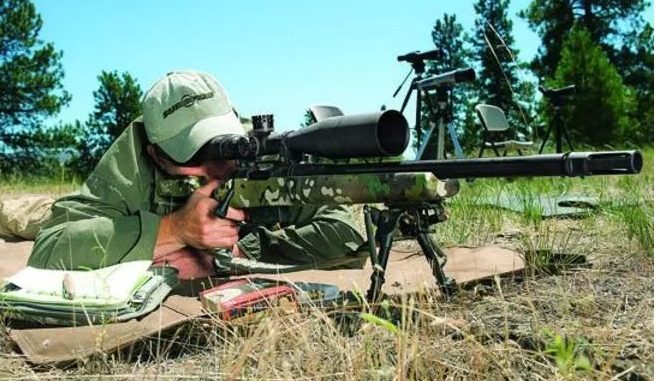
The term “tactical rifle shooting” covers a lot of ground. You may be dealing with one target or a bunch of targets. They might be moving or they might not be, and they are apt to be at distances ranging from powder-burn close to so far out the steel targets ring with an accent. No matter if it is competition or defense, you will need to have the skills to deal with whatever comes your way. Here are a few tips to get you started.
With a .223, you should know your rifle’s point of impact at any distance from 5 yards to 500 yards. For a .308 or similar cartridge, learn where your rifle hits out to 1,000 yards.
This is important not just with the long shots. With the high-mounted optics of an AR-type rifle, the close-range impact will not follow the line of sight. A lot of competitive shooters try head shots at 10 yards and are surprised to find they hit the hostage target below.There is only one foolproof way to know the impacts for your rifle, optic, and ammo: You must shoot your rifle at each distance. Do this at 3, 5, 7, and 10 yards, then work your way out in 10-yard increments to 100 yards. Shoot at 50-yard increments past that.
Only bullet holes in the target can provide 100 percent correct data on where you will hit at any given distance.
Learn Wind
Rifle shooting is a science, but shooting in wind is an art. No computer or ballistics program can help you. Learn to read the wind and develop the instinctive ability to make the shot quickly. How? There is only one way. Shoot often at long-range targets while the wind is blowing. Use a good spotter to call your hits. Take notes. Don’t get hung up on one range or location, but vary the distance, the terrain, and the weather conditions.
Get Past Prone
You should learn to shoot from odd angles: around barriers, under cars, and from every weird position you can think of as matches increasingly require shooting from non-traditional positions. For example, learn to shoot under barricades like cars or lying facedown with the rifle turned sideways. Learn where the bullet will hit. The rifle will not shoot to the same point of impact if it is tilted to the left or right, or if it is being held upside down.
Practice What You Hate
We all tend to practice the shooting we love to do. But odds are that you are already good at that. Pick a specific skill set you need to work on and bring that to your practice sessions.
When you do poorly on a stage at a match, go home and practice whatever it was that gave you trouble. As you improve, be ready for the next thing. Learn to adjust your strategy with your emerging skills. Once you master shooting one of the targets you hate, move on to the next. That’s how you build a full and well-rounded skill set.
Buy More Ammo
Don’t get hung up on your gear. You need guns that are reliable and fit well, but that’s it. The next cool rail-mounted gadget will not make you a better shooter. Instead, take that money and buy more ammo for practice. The guy who has burned enough powder so he can hit the target fastest is the guy that will win the match, not the guy who dragged his gun through the gadget catalog.
Master Your Rifle
Make your rifle your BFF. Get to know it intimately. Learn the trigger so well that you know to the millisecond when it will break. Develop the skills to reload or clear a jam without looking or thinking. Make the rifle an extension of yourself by shooting it often and dry-firing it every day. Tear it down and put it back together. Make it your constant companion.
Shoot Smart
Practice means permanent, not perfect. If you practice with bad habits, you will shoot with bad habits. To learn correct technique, take a class from a professional. But if you don’t have the time and money for that, attend some local matches and learn from the top guys there.
Develop Your Own Style
Learn your strengths and weaknesses and develop your skills around them. For example, a lot of shooters can shoot on the run. But if that is not your strength, learn how to pick places where you can stop and engage multiple targets from a stationary position. Then move to the next position and shoot more targets, and so on. The extra second or two you spend doing this is more than made up for by the higher number of hits.
At the same time, practice your weaknesses until they become your strengths. If your style is not changing, evolving, and emerging, you aren’t doing it right.
Adjust on the Fly
If something is not working, don’t get stuck on stupid and keep repeating it. For example, when you’re shooting at long-range rifle targets and missing, don’t keep shooting at the same spot over and over.
If you break the shot well and miss, you might try one more just to be sure it’s not you. But if you miss that one too, don’t keep doing the same thing. Not sure where the shot went? Try holding high, left, right, and low, and work around the clock.
This assumes, of course, that you know your hold for that distance, so the misses are small. If you use a known hold and miss low, you probably only missed by a little, so hold a little high for the next shot. The point is, don’t get stuck shooting again and again at the same spot. If it’s not working, move your aiming point before you discover that you are out of time and ammo.



Be the first to comment